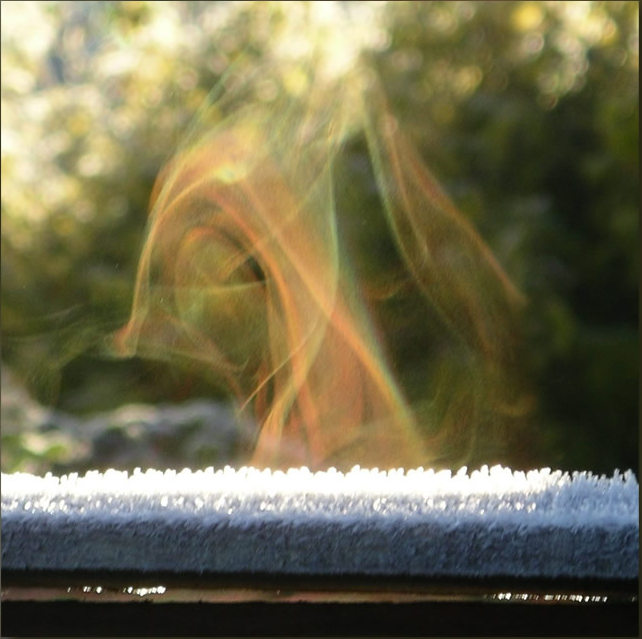Sublime Iridescence
Sublime Iridescence: A Phenomenon of Nature's Artistry
When it comes to atmospheric optics, nature has a way of enchanting us with its stunning displays of light and color. One such captivating phenomenon is known as "sublime iridescence." It is a spectacle that occurs when sunlight interacts with tiny water droplets or ice crystals in the atmosphere, creating a mesmerizing array of vibrant colors.
The delicate iridescent tendrils captured by Dan Gilder in Manchester, England, exemplify the ethereal beauty of this phenomenon. On a frosty morning, as the sun's rays gently warmed the ice crystals on a fence, a breathtaking display of colors emerged. Some of the ice crystals sublimated directly into water vapor, while others melted and evaporated, creating an environment where water vapor could condense and form myriad tiny droplets.
Each of these minuscule droplets acts as a prism, refracting and diffracting the sunlight that passes through them. This diffraction gives rise to the enchanting iridescent colors that dance before our eyes. The interplay between the size of the droplets and the angle at which the sunlight strikes them determines the specific colors that are visible.
Sublime iridescence is just one example of the myriad optical effects that surround us in our everyday lives. From rainbows to halos, these phenomena remind us of the intricate workings of light in our atmosphere. They serve as a reminder of the wonders of nature and the vast complexity that exists within our world.
To fully appreciate and understand sublime iridescence, it is important to delve into the scientific principles behind it. The phenomenon arises from a combination of diffraction and interference. Diffraction refers to the bending or spreading out of light as it passes through an opening or around an obstacle, while interference occurs when two or more light waves interact with each other, resulting in reinforcement or cancellation of certain wavelengths.
In the case of sublime iridescence, the diffraction of sunlight by the tiny droplets causes the light waves to spread out and interfere with each other. This interference leads to constructive or destructive interference, depending on the path length difference between the waves. The resulting pattern of constructive interference produces the vibrant colors that we observe.
The specific colors seen in sublime iridescence can vary depending on a range of factors. The size and shape of the droplets, as well as the angle at which sunlight strikes them, play a crucial role in determining the colors that are visible. Smaller droplets tend to produce blue and violet hues, while larger droplets may give rise to reds and oranges. The angle of the sunlight also influences the intensity and distribution of colors.
Interestingly, sublime iridescence is not limited to water droplets alone. Ice crystals can also create similar displays of color. When sunlight interacts with ice crystals suspended in the atmosphere, such as those found in cirrus clouds or frost, the same principles of diffraction and interference come into play. This phenomenon is often observed in high-altitude clouds, where the ice crystals take on a variety of shapes and sizes, leading to a stunning array of colors.
Sublime iridescence serves as a reminder of the intricate beauty that exists in our natural world. It invites us to pause and marvel at the delicate interplay between light and matter, and to appreciate the awe-inspiring artistry of nature. So, the next time you find yourself captivated by the enchanting colors dancing before your eyes, take a moment to reflect on the scientific wonders that underlie this sublime phenomenon.

Fence Iridescence by Dan Gilder of Manchester, England. ©Dan Gilder, shown with permission.
Dan imaged these delicate iridescent tendrils curling up from a sunlit fence top last Sunday morning 7th December. There had been an overnight frost and the sun was warming the ice crystals on the fence. Some ice was probably subliming directly to water vapour, other crystals had melted and the water was evaporating.
Once mixed and cooled by the cold air, the water vapour condensed back into myriad tiny droplets each of which individually diffracted the sun's light to form the iridescent colours.
Optical effects are everywhere.

Note: this article has been automatically converted from the old site and may not appear as intended. You can find the original article here.
Reference Atmospheric Optics
If you use any of the definitions, information, or data presented on Atmospheric Optics, please copy the link or reference below to properly credit us as the reference source. Thank you!
-
<a href="https://atoptics.co.uk/blog/sublime-iridescence/">Sublime Iridescence</a>
-
"Sublime Iridescence". Atmospheric Optics. Accessed on November 26, 2024. https://atoptics.co.uk/blog/sublime-iridescence/.
-
"Sublime Iridescence". Atmospheric Optics, https://atoptics.co.uk/blog/sublime-iridescence/. Accessed 26 November, 2024
-
Sublime Iridescence. Atmospheric Optics. Retrieved from https://atoptics.co.uk/blog/sublime-iridescence/.